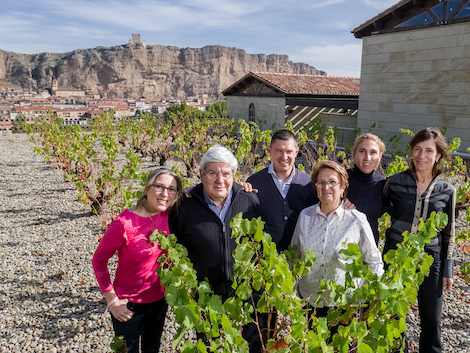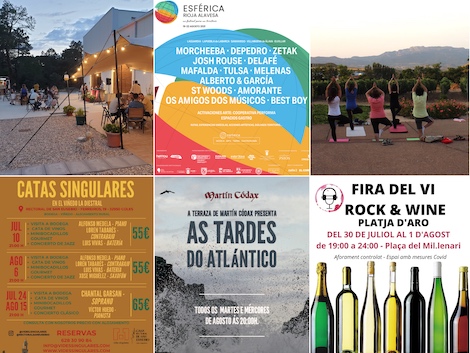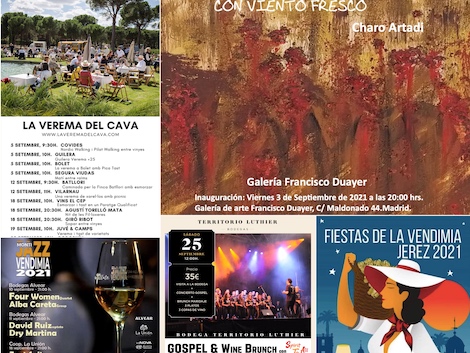Queirón: a family house on the beach in Rioja Oriental

The entrance door to Queirón, in the charming and tidy Bodega District in Quel, a farming village on the banks of the Cidacos River in Rioja Oriental, accurately reflects the professional history of Gabriel Pérez, a producer and winegrower with over four decades of experience in wine.
Discreet and integrated into the landscape of stone, brick and wood of a district built in the 18th century that had up to 350 bodegas, behind this façade lies Gabriel's conscientious work over a decade to create a modern four-storey winery that maintains the traditional construction used in Quel, his home village and where he still lives. Equipped to handle grapes during the harvest, winemaking and ageing, it works by gravity, taking advantage of the natural slope of the hill on which it is located. It also boasts a social area, like all the caves in the Bodega district nowadays, where they welcome professional visitors and host family get-togethers.
"Queirón is my parents' beach house,” says his daughter Raquel, who is responsible for the management of the family business. "At 74 years old, my father still goes to the vineyard and the winery and says he has no intention of retiring.”
The revival of La Pasada
Back in the seventies, when half a dozen cooperatives in the region were selling their grapes to wineries in the other two Rioja areas, Gabriel and his wife Mari Luz Cuevas began to buy vines around Quel. In the eighties, while other farmers uprooted vineyards to grow the more profitable almond trees or switched to the flourishing mushroom industry, Gabriel literally took to the hills.
Convinced of the potential of an area where grapes had always been grown, Gabriel planted Tempranillo at 800 metres elevation in La Pasada, a rugged 10-hectare site with sandy-clay soils and steep slopes at the limit of cultivation in the Sierra de Yerga, where the Atlantic and continental climates meet the light of the Mediterranean. Now, at Queirón, they continue to grow Tempranillo at elevation, but they are also recovering terraces to plant Maturana Blanca.
"My father was a crazy visionary, but also very wise," says Leticia Pérez Cuevas, an engineer at the European Space Agency but now a full-time grower in charge of the 300 hectares of family vineyards along with a team of almost 30 people. Of these vineyards, around 100 are grown organically since 2011, but they want to reach 120 by 2022. "It is practically impossible to grown all of them organically", Leticia says, "but we do try to farm as balanced and efficiently as possible, providing only the necessary organic matter for the vines and mulch with mushroom compost from our neighbours, limiting plant growth and avoiding tasks that involve the use of tractors and CO² emissions.”
Ontañón and its partnership with Mercadona
Located between 600 and 800 metres on the slopes of the Yerga mountains, a significant part of the grapes that Leticia and her team look after are destined for Ontañón, the winery that Gabriel and Mari Luz founded in 1985 to label with their own brand the wine that they had previously made for others.
One of those wines was the popular Don Pedro de Blas Moscatel, which Gabriel began selling to a group of 15 shops in Valencia owned by the now famous businessman Juan Roig. As Mercadona grew, so did Gabriel's winery, producing up to 12 million bottles of exclusive brands for Spain's leading supermarket.
The balance, after more than 30 years of partnership, is very positive, says Raquel. "We are proud to have succeeded to offer a wine for daily consumption and good quality to everyone. We are obsessed with the democratisation of wine, but we are also totally clear about what we want to express with each brand.”
In parallel to working with Mercadona, the Pérez Cuevas family -Gabriel and Mari Luz and their children Raquel, Leticia, Rubén (winemaking) and María (human resources)- have been busy building up a group that today includes the modern Ontañón facilities in Aldeanueva de Ebro, a winery dedicated exclusively to wine tourism in Logroño built by Miguel Ángel Sáinz, an artist from La Rioja and a great friend of Gabriel's, as well as projects in Rueda (Vetiver) and Ribera del Duero (Dominio de la Abadesa).
19th century Garnacha vines
Now, the family's darling is Queirón and its wines launched in 2020, for which they have hand-picked 25 to 30 hectares in Quel. The oldest and most cherished plot is El Arca, bought from a family supplier to whom Gabriel promised he would not grub it up.
Dating from at least 1892, its 0.89 hectares of old garnachas are mixed with some white varieties that the family is trying to identify in a joint project with the University of La Rioja. There are a lot of layered vines and missing plants in these soils of sand, silt and clay, which are replanted with plant material from the vineyard itself to reach a total production that never exceeds 3,000 kg/ha and which is destined for their red El Arca. Fermented in barrels and aged in French and American oak and concrete eggs, the second vintage, 2018 (700 bottles, €55), is floral, has delicious crisp red fruit and great finesse.
El Arca is the family's first Viñedo Singular, but Queirón's first wine was Queirón de Gabriel Reserva 2011 (30,000 bottles, €32), which rested in the depths of the cellar until 2020. It is a blend of Tempranillo from La Pasada and Graciano from El Pozo, a vineyard with sandy soils and river pebbles, common in Quel. Made with long macerations and 24 months in new French and American oak barrels, it is a classic style, just like the ones Gabriel likes. It was he who planted the vines and that is why the wine bears his name.
The Pérez Cuevas family's pride in their roots and their village is represented by Mi Lugar (30,000 bottles, €21.50), a blend of Tempranillo and Garnacha fermented and aged in barrels and vats. The grapes come from five micro-plots with goblet-trained vines, a system they like and want to return to. One of these plots is La Bartola, with Rioja Oriental's distinctive red clay and sandy soils with pebbles, which withstand drought well. At 670 metres elevation, it is a peaceful spot, surrounded by cherry trees and scrubland vegetation, with the Isasa peak in the backdrop. The other Mi Lugar vineyards, also bush-trained and planted in poor soils are El Poeta, La Perdida, El Arenal and Hoyo Judío.
Combining haute couture and Formula 1
Ensayos Capitales is a search for wines at the limit, both in terms of wine growing and winemaking. For Rubén, this limited series of 3,000 to 5,000 bottles is a combination of "haute couture and Formula 1,” a way of testing ideas that, if they are successful, can become part of the rest of the group's wines.
The first Ensayo (trial, in English) to see the light of day was a single-varietal Graciano from the El Pozo vineyard, made without sulphites and sold in a Port-style bottle with elegant and highly informative labels. Then came Queirón's first white wine, a Tempranillo Blanco aged in clay tinaja for just over a year (€34). The process is described very graphically by respected journalist Pablo García Mancha, who is in charge of Queirón and Ontañón's communication, in this illustrated leaflet, which reads almost like a comic book.

For Rubén, who defines this No. 2 as "more oenological than a vineyard wine", it is a way of learning to work with white varieties. No. 3, which will be on sale at the end of the year, is a Tempranillo from La Pasada that plays with the sun. "We lay the grapes for five to seven days on reeds that farmers here use with their prunes and let them to dry out in the sun and to gain phenolic maturity," he explains. The wine, which will be called Ensayo Capital Nº 3 Tempranillo Asoleao, has 15.5% alcohol, a lot of concentration and notes of prunes on the palate. Undoubtedly, a true curiosity in the area.
The Ensayos will continue, says Rubén, who is already working on a Viura wine as a tribute to his mother. They are also going to focus on singular vineyards from small plots, "seeking the singularity" of Quel, the family village "where Bacchus has more temples than he had in Greece,” as the 19th century playwright Bretón de los Herreros, who was born in the village, wrote.

Yolanda Ortiz de Arri
A journalist with over 25 years' experience in national and international media. WSET3, wine educator and translator
Wine tastings in September 2021
NEWSLETTER
Join our community of Spanish wine lovers






